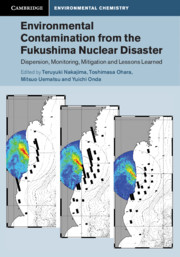 Environmental Contamination from the Fukushima Nuclear Disaster
Environmental Contamination from the Fukushima Nuclear Disaster Book contents
- Environmental Contamination from the Fukushima Nuclear Disaster
- Cambridge Environmental Chemistry Series
- Environmental Contamination from the Fukushima Nuclear Disaster
- Copyright page
- Contents
- Contributors
- Preface
- Acknowledgements
- Part I Transport of Radioactive Materials in the Environment
- 1 Introduction
- 2 Estimation of Environmental Releases of Radioactive Materials
- 3 Diffusion in the Atmosphere
- 4 Global Transport of Radioactive Materials
- 5 Ocean Transport of Radioactive Materials
- 6 Diffusion and Deposition of Radioactive Materials in the Terrestrial Environment
- Part II Development and Future Issues for the Infrastructure of Disaster Prevention
- Part III Lessons and Future Issues from the Fukushima Accident
- Glossary
- Names of Locations
- Index
- References
3 - Diffusion in the Atmosphere
from Part I - Transport of Radioactive Materials in the Environment
Published online by Cambridge University Press: 16 August 2019
- Environmental Contamination from the Fukushima Nuclear Disaster
- Cambridge Environmental Chemistry Series
- Environmental Contamination from the Fukushima Nuclear Disaster
- Copyright page
- Contents
- Contributors
- Preface
- Acknowledgements
- Part I Transport of Radioactive Materials in the Environment
- 1 Introduction
- 2 Estimation of Environmental Releases of Radioactive Materials
- 3 Diffusion in the Atmosphere
- 4 Global Transport of Radioactive Materials
- 5 Ocean Transport of Radioactive Materials
- 6 Diffusion and Deposition of Radioactive Materials in the Terrestrial Environment
- Part II Development and Future Issues for the Infrastructure of Disaster Prevention
- Part III Lessons and Future Issues from the Fukushima Accident
- Glossary
- Names of Locations
- Index
- References
Summary
In nuclear power plant accidents, enormous amounts of radioactive substances are released over a relatively short period of time (several hours to days). The direction and range over which the substances are dispersed and the amount deposited on the ground surface are influenced not only by the amount that is released but also by meteorological conditions at the time of and immediately following an accident. The most important meteorological factors include wind direction, wind speed and precipitation. Whereas wind direction and speed directly affect the atmospheric transport of radioactive substances, precipitation is the predominant factor that controls the removal of these substances from the atmosphere by wet deposition.
- Type
- Chapter
- Information
- Environmental Contamination from the Fukushima Nuclear DisasterDispersion, Monitoring, Mitigation and Lessons Learned, pp. 62 - 111Publisher: Cambridge University PressPrint publication year: 2019


